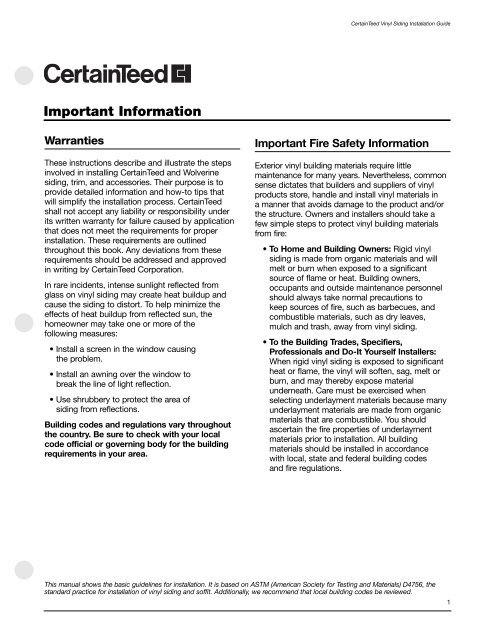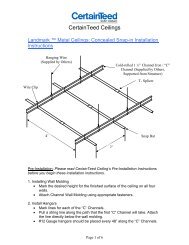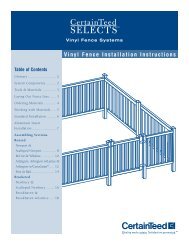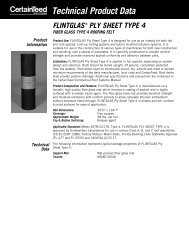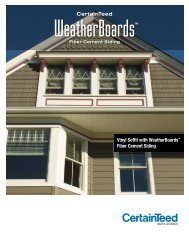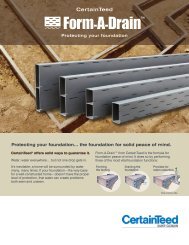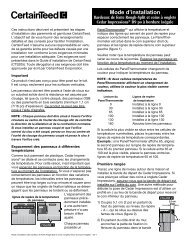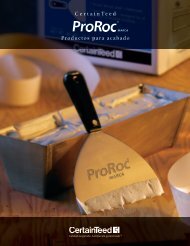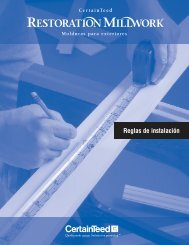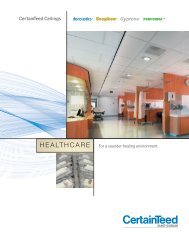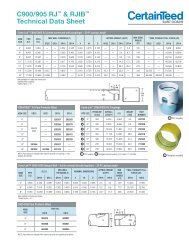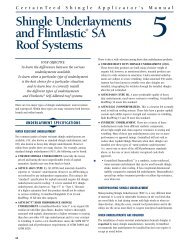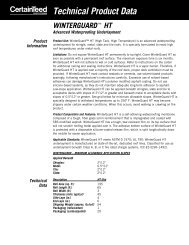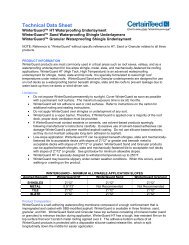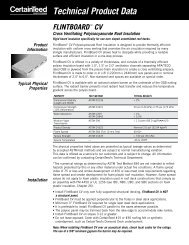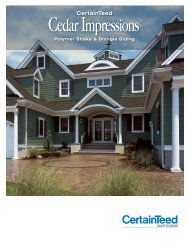Installation Guide - CertainTeed
Installation Guide - CertainTeed
Installation Guide - CertainTeed
You also want an ePaper? Increase the reach of your titles
YUMPU automatically turns print PDFs into web optimized ePapers that Google loves.
Important Information<br />
Warranties<br />
These instructions describe and illustrate the steps<br />
involved in installing <strong>CertainTeed</strong> and Wolverine<br />
siding, trim, and accessories. Their purpose is to<br />
provide detailed information and how-to tips that<br />
will simplify the installation process. <strong>CertainTeed</strong><br />
shall not accept any liability or responsibility under<br />
its written warranty for failure caused by application<br />
that does not meet the requirements for proper<br />
installation. These requirements are outlined<br />
throughout this book. Any deviations from these<br />
requirements should be addressed and approved<br />
in writing by <strong>CertainTeed</strong> Corporation.<br />
In rare incidents, intense sunlight reflected from<br />
glass on vinyl siding may create heat buildup and<br />
cause the siding to distort. To help minimize the<br />
effects of heat buildup from reflected sun, the<br />
homeowner may take one or more of the<br />
following measures:<br />
• Install a screen in the window causing<br />
the problem.<br />
• Install an awning over the window to<br />
break the line of light reflection.<br />
• Use shrubbery to protect the area of<br />
siding from reflections.<br />
Building codes and regulations vary throughout<br />
the country. Be sure to check with your local<br />
code official or governing body for the building<br />
requirements in your area.<br />
<strong>CertainTeed</strong> Vinyl Siding <strong>Installation</strong> <strong>Guide</strong><br />
Important Fire Safety Information<br />
Exterior vinyl building materials require little<br />
maintenance for many years. Nevertheless, common<br />
sense dictates that builders and suppliers of vinyl<br />
products store, handle and install vinyl materials in<br />
a manner that avoids damage to the product and/or<br />
the structure. Owners and installers should take a<br />
few simple steps to protect vinyl building materials<br />
from fire:<br />
• To Home and Building Owners: Rigid vinyl<br />
siding is made from organic materials and will<br />
melt or burn when exposed to a significant<br />
source of flame or heat. Building owners,<br />
occupants and outside maintenance personnel<br />
should always take normal precautions to<br />
keep sources of fire, such as barbecues, and<br />
combustible materials, such as dry leaves,<br />
mulch and trash, away from vinyl siding.<br />
• To the Building Trades, Specifiers,<br />
Professionals and Do-It Yourself Installers:<br />
When rigid vinyl siding is exposed to significant<br />
heat or flame, the vinyl will soften, sag, melt or<br />
burn, and may thereby expose material<br />
underneath. Care must be exercised when<br />
selecting underlayment materials because many<br />
underlayment materials are made from organic<br />
materials that are combustible. You should<br />
ascertain the fire properties of underlayment<br />
materials prior to installation. All building<br />
materials should be installed in accordance<br />
with local, state and federal building codes<br />
and fire regulations.<br />
This manual shows the basic guidelines for installation. It is based on ASTM (American Society for Testing and Materials) D4756, the<br />
standard practice for installation of vinyl siding and soffit. Additionally, we recommend that local building codes be reviewed.<br />
1


